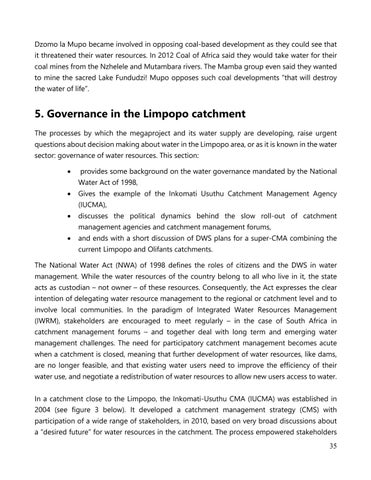Dzomo la Mupo became involved in opposing coal-based development as they could see that it threatened their water resources. In 2012 Coal of Africa said they would take water for their coal mines from the Nzhelele and Mutambara rivers. The Mamba group even said they wanted to mine the sacred Lake Fundudzi! Mupo opposes such coal developments “that will destroy the water of life”.
5. Governance in the Limpopo catchment The processes by which the megaproject and its water supply are developing, raise urgent questions about decision making about water in the Limpopo area, or as it is known in the water sector: governance of water resources. This section: •
provides some background on the water governance mandated by the National Water Act of 1998,
•
Gives the example of the Inkomati Usuthu Catchment Management Agency (IUCMA),
•
discusses the political dynamics behind the slow roll-out of catchment management agencies and catchment management forums,
•
and ends with a short discussion of DWS plans for a super-CMA combining the current Limpopo and Olifants catchments.
The National Water Act (NWA) of 1998 defines the roles of citizens and the DWS in water management. While the water resources of the country belong to all who live in it, the state acts as custodian – not owner – of these resources. Consequently, the Act expresses the clear intention of delegating water resource management to the regional or catchment level and to involve local communities. In the paradigm of Integrated Water Resources Management (IWRM), stakeholders are encouraged to meet regularly – in the case of South Africa in catchment management forums – and together deal with long term and emerging water management challenges. The need for participatory catchment management becomes acute when a catchment is closed, meaning that further development of water resources, like dams, are no longer feasible, and that existing water users need to improve the efficiency of their water use, and negotiate a redistribution of water resources to allow new users access to water. In a catchment close to the Limpopo, the Inkomati-Usuthu CMA (IUCMA) was established in 2004 (see figure 3 below). It developed a catchment management strategy (CMS) with participation of a wide range of stakeholders, in 2010, based on very broad discussions about a “desired future” for water resources in the catchment. The process empowered stakeholders 35





